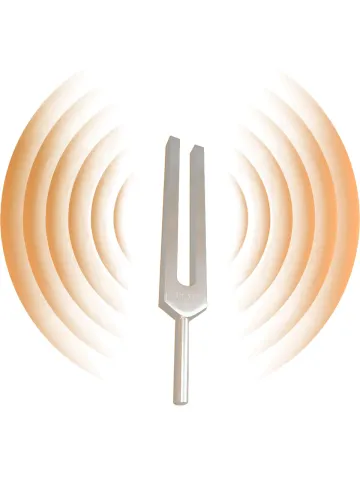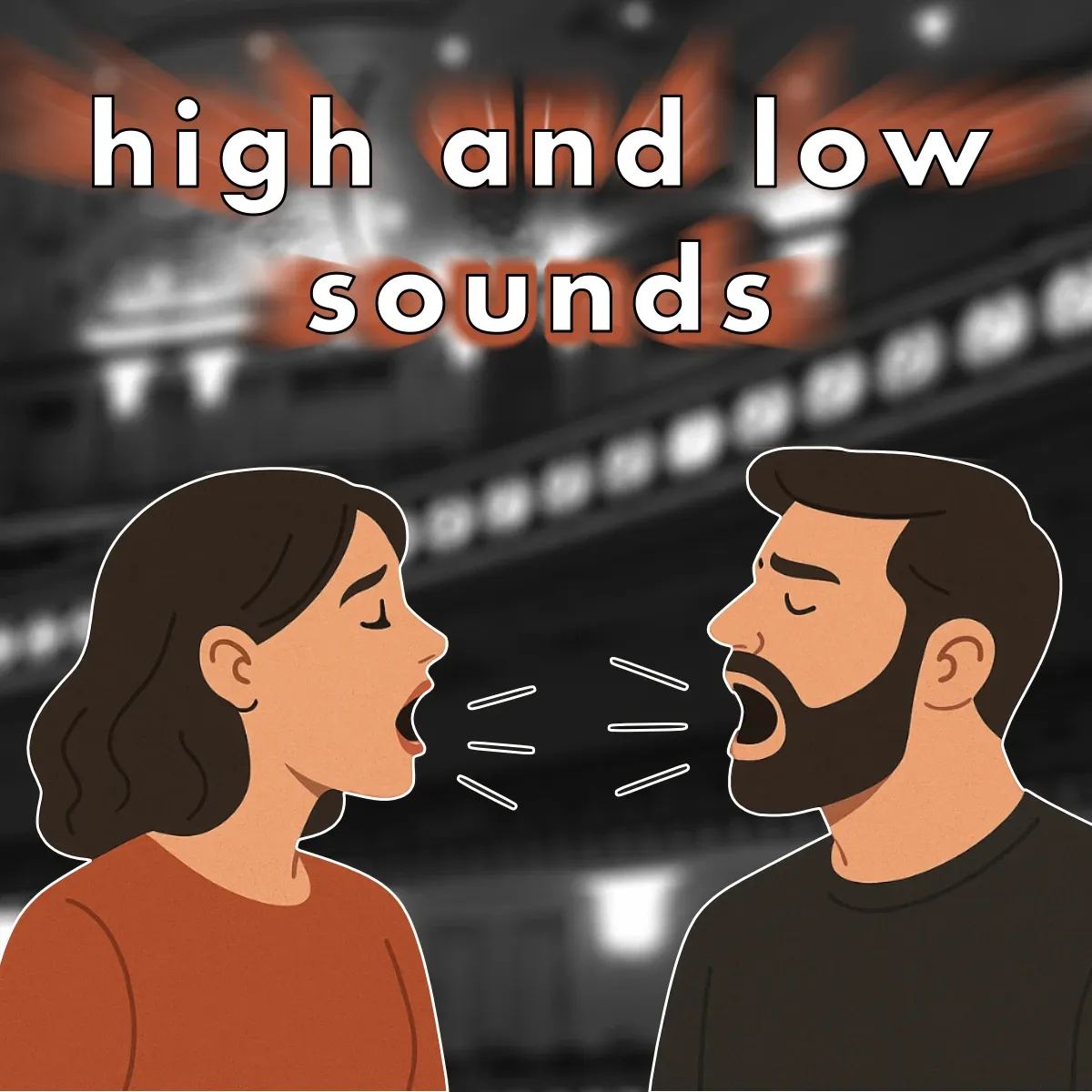Pitch of Sound and How People Hear High and Low Sounds
Learn what pitch and frequency of sound are, how high and low sounds are different, what ultrasound and infrasound mean, and how people hear them.
The Nature of Sound and How People Hear It

Vibration of a guitar string and the emergence of a sound wave
Sound is a physical event. It is made of invisible waves that move through the air when something vibrates. For example, when a bell rings or a guitar string is plucked, it vibrates and makes the air around it move in waves. Our ears pick up these sound waves and send information about them to our brain. The brain then helps us understand what we are hearing. So, when we talk about pitch, we need to think about both the physical sound waves and how our mind hears them. You can read more about what sound is and how people hear sound.
Frequency of Air Vibrations
When you pluck a guitar string, it moves back and forth very quickly. This movement makes the air molecules near the string move back and forth too, creating a sound wave. Frequency means how many times something vibrates in one second. So, the frequency of a sound wave tells us how often the air moves back and forth each second.
Another important idea is wavelength. This is the distance a sound wave travels during one full vibration. Wavelength and frequency are connected: when the frequency is higher, the wavelength is shorter. When the frequency is lower, the wavelength is longer.
Frequency means how many times a sound wave vibrates in one second.
What Is Pitch? High and Low Sounds
The frequency of a sound wave is what our brain understands as pitch. The air itself just moves at different speeds, but our brain turns this into the idea of “high” or “low” sounds. In other words, pitch is not really in the air; it is something our mind creates when it hears different frequencies.
Pitch is how our brain hears the frequency of sound waves: if the waves vibrate quickly (high frequency), we hear a high-pitched sound; if they vibrate slowly (low frequency), we hear a low-pitched sound.
In the book “This Is Your Brain on Music,” it says that pitch is a psychological thing—it only exists in our mind, not in the outside world.
So what do we call high and low sounds? A high sound has a high frequency (short sound waves). It sounds sharp or bright. A low sound has a low frequency (long sound waves). It sounds deep or heavy.
EXAMPLES. A man’s voice is usually lower than a woman’s voice. Thunder is a low sound, while a violin makes high sounds.
Why is a man’s voice lower than a woman’s? This is because men have longer and thicker vocal cords and a larger voice box. Their vocal cords vibrate more slowly, making lower-frequency sounds, which we hear as lower pitch.
Measuring Frequency and Pitch

A tuning fork makes a pure sound of one frequency
Sound frequency is measured in hertz (Hz). Hertz tells us how many vibrations happen in one second. For example, 20 Hz means the sound wave vibrates 20 times every second.
Since pitch is how our brain understands frequency, we cannot measure pitch directly. But we can measure frequency to guess what pitch we will hear. The higher the frequency, the higher the pitch we hear. The lower the frequency, the lower the pitch.
Infrasound and Ultrasound

Blue whales produce infrasounds for communication, which can travel thousands of kilometers, and these sounds cannot be heard by humans
The human ear can only hear sounds within a certain range of frequencies. This range can be different for each person, depending on age, health, and other factors. On average, we can hear sounds from 20 Hz up to 20,000 hertz (20,000 hertz = 20 kilohertz).
If a sound has a frequency below 20 Hz or above 20,000 Hz, we cannot hear it. A sound below 20 Hz is called “infrasound.” A sound above 20,000 Hz is called “ultrasound.”
Infrasound means sounds with frequencies below 20 Hz. Ultrasound means sounds with frequencies above 20,000 Hz. People cannot hear infrasound or ultrasound.
EXAMPLES. Some animals make infrasound or ultrasound. For example, blue whales make infrasound between 1 and 20 Hz. According to research published by the Acoustical Society of America, whale sounds can travel more than 1,500 kilometers.
Bats use ultrasound to find their way in the dark, hunt, and communicate. Their ultrasound calls can be higher than 100,000 hertz.
Frequency Spectrum and Timbre
The sounds we hear from most things are actually made up of many different frequencies at once. For example, when you pluck a guitar string, the string vibrates at several frequencies at the same time. That means the air moves in many ways at once. The lowest frequency is called the main frequency, and the other frequencies are called overtones. The overtones are usually related to each other in simple ways (for example, one might be twice as fast as another), which makes the sound pleasant or “musical.”

The frequency spectrum can be visualized as lines of different sizes and colors

Every instrument has its own unique timbre or set of overtones, which depends on the shape, material, and way of producing sound
The shape, size, and material of a musical instrument affect which frequencies are present in its sound. The same goes for our voice—our vocal cords, mouth, and nose change which frequencies come out. How we make the sound and how it changes over time also affect which frequencies are present. So, a frequency spectrum is all the frequencies that make up a sound—including both main and extra (overtone) frequencies. The spectrum makes each sound unique and changes how we hear it. The way our ears and brain understand this mix of frequencies is called timbre (pronounced “tam-ber”), or tone color. Timbre helps us tell different musical instruments or voices apart—even if they play or sing the same note. So, timbre is how a sound feels to us—it depends on which frequencies are present and how they change over time. Because of timbre, we can tell who is talking or which instrument is playing just by listening.
A frequency spectrum is all the different frequencies that make up a sound, including main tones and overtones.
Timbre or tone color is how a sound feels to us because of its mix of frequencies and how they change over time.
You can learn more about other features of sound, such as loudness, in this table of sound features.
Conclusion
The frequency of sound waves and pitch help us understand how we hear everything around us—including music. From slow infrasound to fast ultrasound, all these are just vibrations in the air that our ears pick up differently. Even though people can only hear sounds from about 20 to 20,000 hertz, many animals and machines use infrasound or ultrasound for communication or finding their way.
But sound isn’t just about frequency and pitch. Its character—how it feels and how we recognize it—depends on its spectrum of frequencies. Timbre lets us tell voices apart, recognize musical instruments, and feel emotions in speech. Our sense of hearing comes from physics (how air moves), biology (how our ears work), and our mind (how we understand sounds). Learning about these things helps us see how rich and interesting the world of sound really is.
Information sources
- Study on the sounds of blue whales, Journal of the Acoustical Society of America
- The book "Sound: Listening, Hearing, Observing" by Michel Chion
- The book "On Music. The Science of Human Obsession with Sound", by Daniel Levitin
Author team instrumental-music.eu
Last updated:

Pitch of voice: a man’s voice is usually lower, and a woman’s voice is usually higher